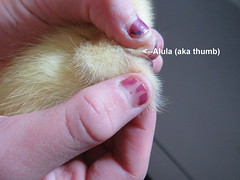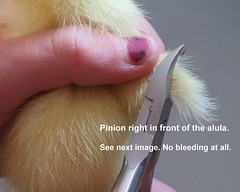Excuse Hannah's nails. Generally, pictures are not planned.
I simply take pictures as life happens.
For any poultry that can fly off, we pinion.
If done properly at the right time (days 2-5), the process is quick and painless with little to no bleeding. Some people think the practice is cruel, but if you speak to people who actually have performed it, they will tell you the young birds are not harmed.
I do not permanently pinion older birds because they will feel extreme pain and will bleed. You can cut the flight feathers themselves. That is a temporary form of pinioning that needs to be repeated a couple of times a year. It is stressful on the birds because of the handling and restraining. They do not feel the feathers being cut.
I have been given free birds from people who did not permanently pinion many times. They had issues with neighbors because the birds roosted on cars and roofs leaving stinking piles. Other birds caused issues when they flew into enclosed gardens and stole the vegetables or fouled pools and private ponds. Some grew tired of cutting flight feathers. From those birds, I received a black eye from a duck as I trimmed its wing.
Why pinion?
- required by law in some circumstances
- not everyone has an enclosed aviary
- to protect domestic birds from flying off and starving or being devoured by predators
- to protect native bird populations from interbreeding and overconsumption of their natural resources
- to keep the birds from causing a public nuisance
- legal liability
- to protect birds from head trauma/death from flying into aviary roof
- to keep domestic birds from attempting to migrate (they don't survive)
- to reduce the stress and risk of injury for the birds by preventing the need for temporary pinioning (cutting the flight feathers 2xs a year)
- to keep them out of neighbor's gardens, pools, and fishing ponds
- to keep muscovies from roosting on and fouling cars, carports, houses, etc
In the mid-1990s, I raised the first ducks and geese I purchased without pinioning. In the fall, the geese flew away because they tried to migrate. I was told by a wildlife expert they would likely die because, as domestic birds, they were not hardy enough to survive and did not know how to find food. They would also be susceptible to parasites and diseases not previously exposed to if they did make it far enough. That was awful, but I also learned there was something I could do to prevent it from happening again.
A local vet taught me how to pinion. It is a very simple process. My children have all pinioned a bird. Some of my children were as young as six years old when they did it.
How to pinion:
The process is very quick and simple. The ducklings will resist being held, but they do not react to the snip at all. They do not feel it.
If I am pinioning in a manner to also help me tell the gender, I hold the duckling either front or back facing so I can pinion the correct wing tip for that purpose.
Only one wing is cut which makes them fly in a curve vs a straight line. This allows the mature duck to still fly to escape predators, but it can not go long distances.
Prep: If they are in a brooder vs being with their mother, I make sure that is very clean. A clean, sharp, appropriately sized cutting instrument is needed. I have used nail clippers, nail scissors, regular scissors, and small pruners. I clean the instrument with alcohol. I sit on the floor and usually have a helper.
To Pinion: Hold the duckling in one hand. Extend the wingtip and locate the aluna (aka "thumb"). I use my thumbnail to lightly hold right in front of the aluna and snip with the other hand. If there is a drop of blood, I firmly but gently pinch it a few seconds before letting the duckling go. I check them all a few minutes after and make sure they are doing fine. I have never had a bird get infected or die due to pinioning.


